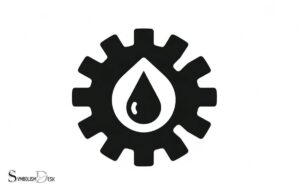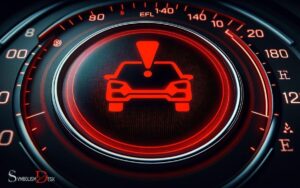Brake Warning Light Symbol Car: Worn Brake Pads!
The brake warning light symbol in a car is a critical alert that signals a problem with the vehicle’s braking system. It is essential to address this warning immediately to maintain safe driving conditions.
The light can indicate several issues, such as low brake fluid, worn brake pads, or a malfunctioning anti-lock braking system (ABS).
Drivers should perform a preliminary check of the brake system and consult a mechanic for a thorough inspection and repair.
The brake warning light is an important dashboard signal that requires immediate attention for several reasons:
- Low Brake Fluid: This could be a sign of a leak in the brake system.
- Worn Brake Pads: Reduced pad thickness can trigger the warning light.
- ABS Issues: Problems with the anti-lock braking system can activate the light.
- Brake System Malfunction: General faults in the brake system, including issues with brake lines or sensors, may be the cause.
Examples of when the brake warning light may come on include:
- After starting the car, if the light stays on, it suggests a serious issue.
- During braking, if the light appears, it may indicate worn brake pads.
- If the light flashes, it could point to an ABS malfunction.
Promptly addressing the brake warning light ensures your vehicle remains safe and reliable on the road.
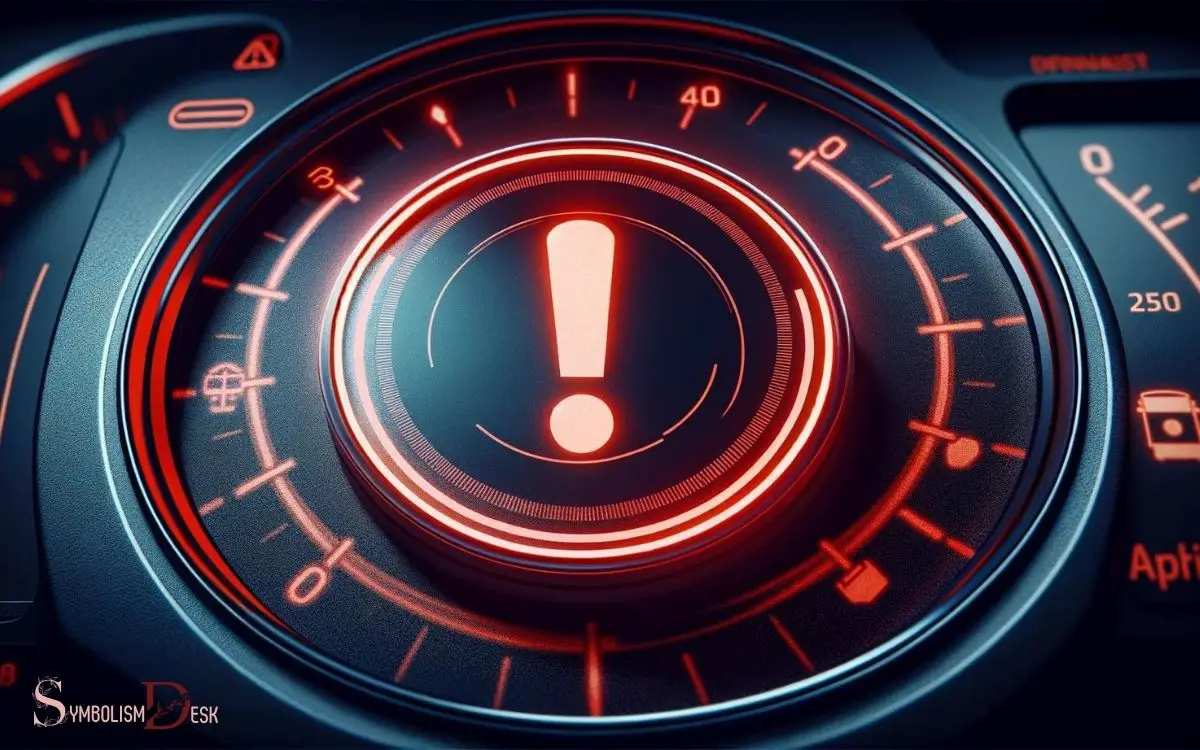
Key Takeaway
Understanding the Brake Warning Light Symbol in Your Car
| Potential Issue | Description | Suggested Action |
|---|---|---|
| Low Brake Fluid | The fluid level in the brake reservoir is too low. | Check for leaks, refill fluid, inspect for wear. |
| Worn Brake Pads | The brake pads have thinned beyond safe limits. | Replace brake pads. |
| ABS Malfunction | The anti-lock braking system is not working. | Diagnose ABS, repair or replace components. |
| Brake System Malfunction | Other faults in brake components or sensors. | Full system diagnostic and repair. |
Common Causes of Brake Warning Light
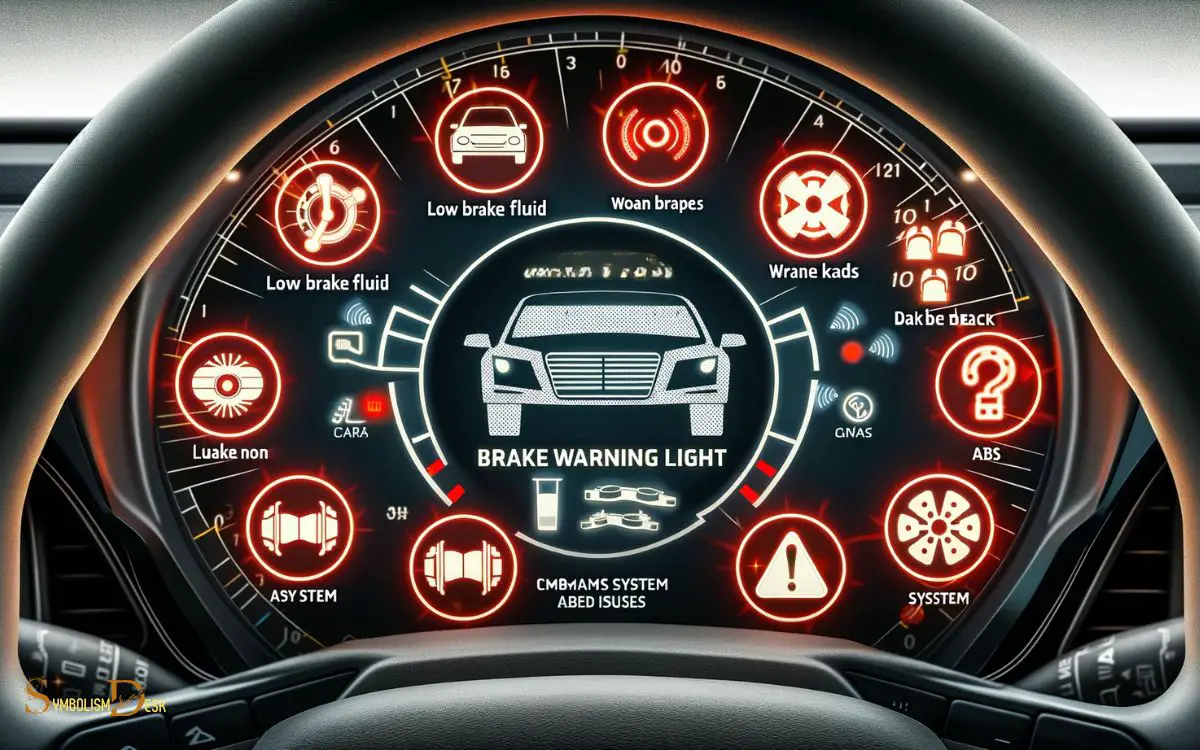
The brake warning light in a car can illuminate due to various common causes, including low brake fluid and worn brake pads.
Low brake fluid is often caused by either normal wear of the brake pads, a leak in the brake system, or it could indicate that the brake pads are worn and need to be replaced. Additionally, the brake warning light may also come on if the parking brake is engaged.
Furthermore, a faulty ABS sensor or a problem with the anti-lock braking system can trigger the brake warning light. It’s crucial to address the warning light promptly to ensure the safety and optimal performance of the vehicle’s braking system.
Ignoring the warning light can lead to potential safety hazards and further damage to the brake system.
Importance of Addressing the Warning Light
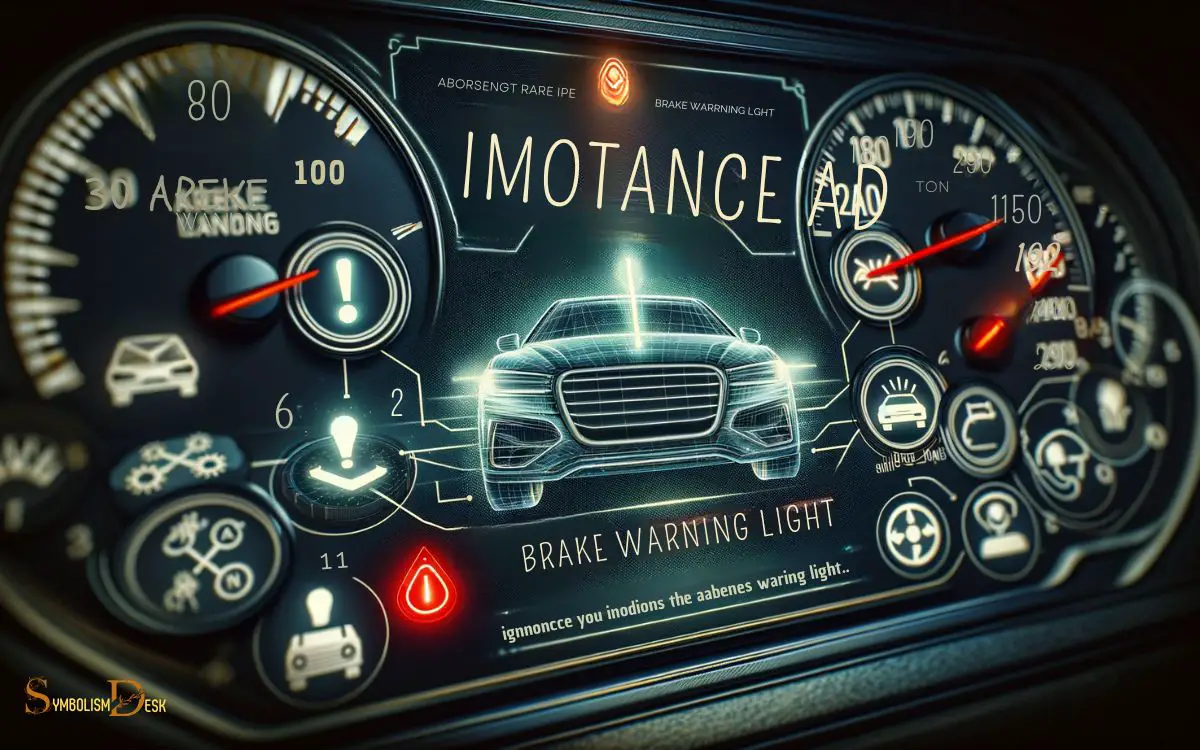
Addressing the warning light is crucial for ensuring the safety and optimal performance of the vehicle’s braking system.
Ignoring the warning light can lead to potentially dangerous situations such as brake failure or decreased braking efficiency.
It’s essential to address the warning light promptly to maintain control over the vehicle and prevent accidents.
Procrastinating on addressing the warning light can result in more extensive and costly repairs, impacting the vehicle’s overall performance.
Additionally, neglecting the warning light can cause increased wear and tear on the braking system, leading to further damage and reduced longevity.
Therefore, it is imperative to take immediate action when the brake warning light illuminates to uphold the safety and functionality of the vehicle’s brakes.
Moving on to the next section, it is important to check the brake fluid levels to ensure the proper functioning of the braking system.
Checking Brake Fluid Levels
When it comes to vehicle maintenance, checking brake fluid levels is crucial for ensuring optimal brake performance. Low brake fluid levels can lead to decreased braking effectiveness and potential safety hazards.
Understanding the signs of low fluid levels and adhering to recommended fluid replacement intervals are essential for maintaining a safe and reliable braking system.
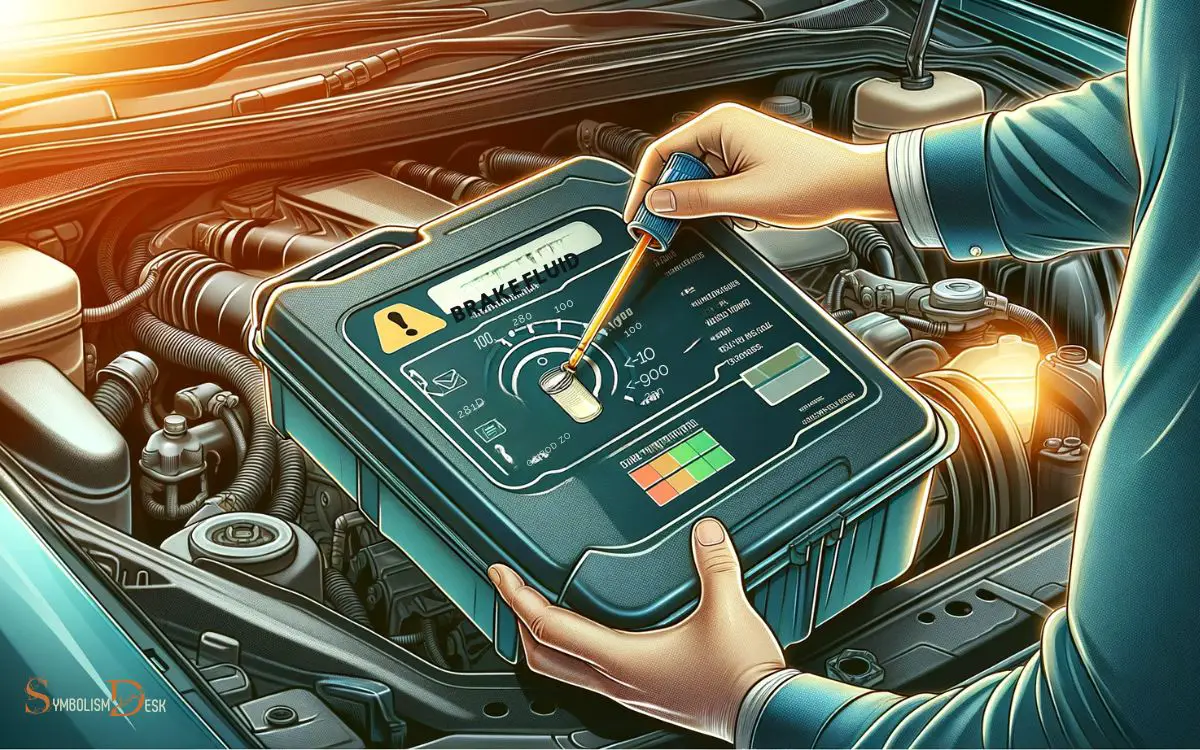
Importance of Fluid Levels
Regularly checking brake fluid levels is crucial for maintaining vehicle safety and performance. Low brake fluid levels can compromise the effectiveness of the braking system, leading to potential safety hazards.
To emphasize the importance of maintaining proper brake fluid levels, consider the following:
- Safety: Adequate brake fluid levels are essential for ensuring that the brakes respond effectively, allowing the vehicle to stop promptly in emergency situations.
- Performance: Insufficient brake fluid can lead to decreased brake responsiveness and increased stopping distances, impacting the overall performance of the vehicle.
- Preventive Maintenance: Regularly monitoring brake fluid levels can help in identifying potential leaks or issues within the braking system, allowing for timely maintenance and preventing costly repairs.
Signs of Low Levels
To check brake fluid levels, drivers should use a dipstick or inspect the fluid reservoir. Low brake fluid levels can lead to decreased braking performance and should be addressed promptly.
Signs of low brake fluid levels include the illumination of the brake warning light on the dashboard, a spongy or soft brake pedal, and increased stopping distances.
When checking the brake fluid reservoir, it’s important to ensure that the vehicle is on a level surface and that the fluid is within the recommended range indicated on the reservoir.
If the brake fluid is found to be low, it may indicate a potential leak in the braking system, and the vehicle should be inspected by a qualified mechanic to identify and rectify the issue.
Regularly monitoring brake fluid levels is essential for maintaining safe and effective braking performance.
Fluid Replacement Intervals
Drivers should regularly check their brake fluid levels and replace the fluid at the recommended intervals to maintain optimal braking performance.
- Safety First: Regular brake fluid checks ensure that the braking system is functioning properly, reducing the risk of accidents due to brake failure.
- Cost-Effective Maintenance: Timely fluid replacement prevents damage to the braking system, saving drivers from expensive repairs in the long run.
- Smooth Braking Experience: Maintaining the recommended fluid levels and replacing it as needed ensures a consistent and responsive braking feel, enhancing the overall driving experience.
Regular maintenance of brake fluid levels is crucial for vehicle safety and performance. Following the manufacturer’s recommendations for fluid replacement intervals is essential in ensuring the braking system operates effectively.
Inspecting Brake Pads and Discs
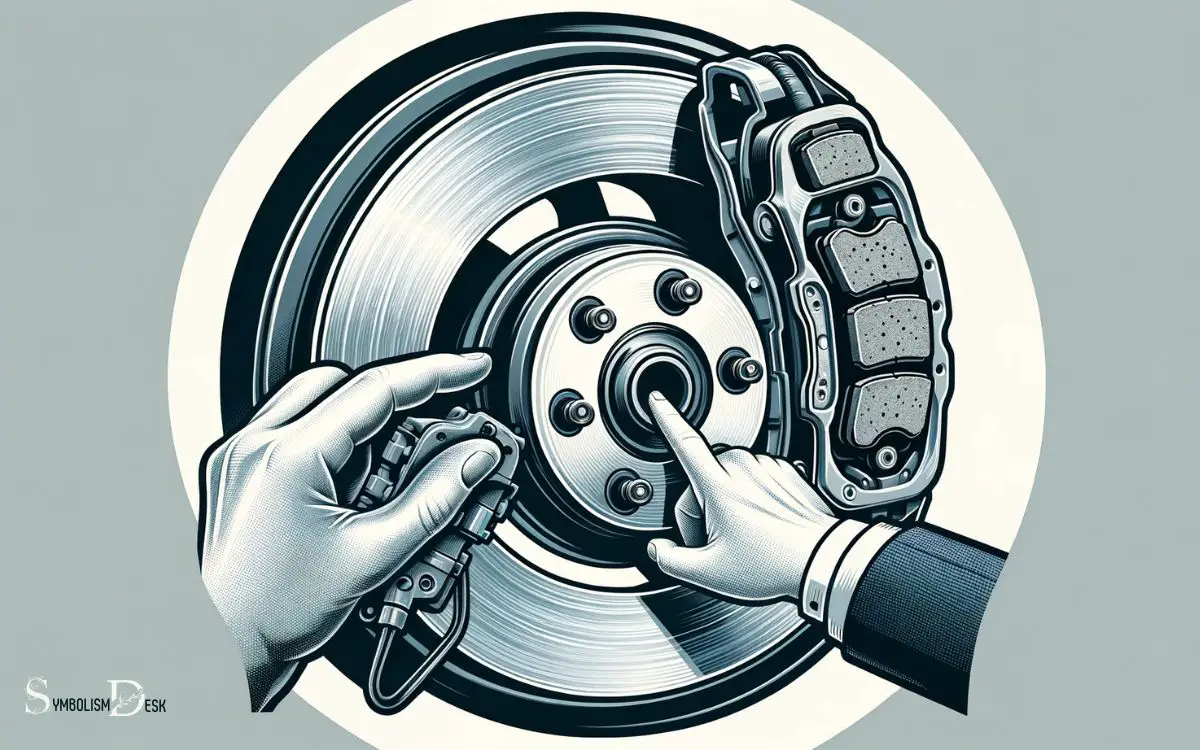
Inspecting the brake pads and discs is essential for maintaining safe driving conditions and optimal brake performance. Start by visually checking the brake pads for wear.
If the pads are less than 1/4 inch thick, they need replacement. Next, examine the brake discs for signs of damage, such as scoring or warping.
Measure the thickness of the discs using a micrometer; replace them if they fall below the manufacturer’s specified minimum thickness.
Additionally, look for any brake fluid leakage around the calipers, as this could indicate a seal or piston problem.
Regular inspections ensure that the brake system operates effectively, preventing potential safety hazards.
Understanding these key inspection points is crucial for vehicle maintenance. Now, let’s delve into comprehending the signs of an ABS malfunction.
Understanding ABS Malfunction
The ABS warning light in a vehicle indicates a malfunction in the Anti-lock Braking System. Understanding the causes of ABS failure is crucial for maintaining vehicle safety. Handling ABS malfunctions promptly is essential to prevent potential accidents on the road.
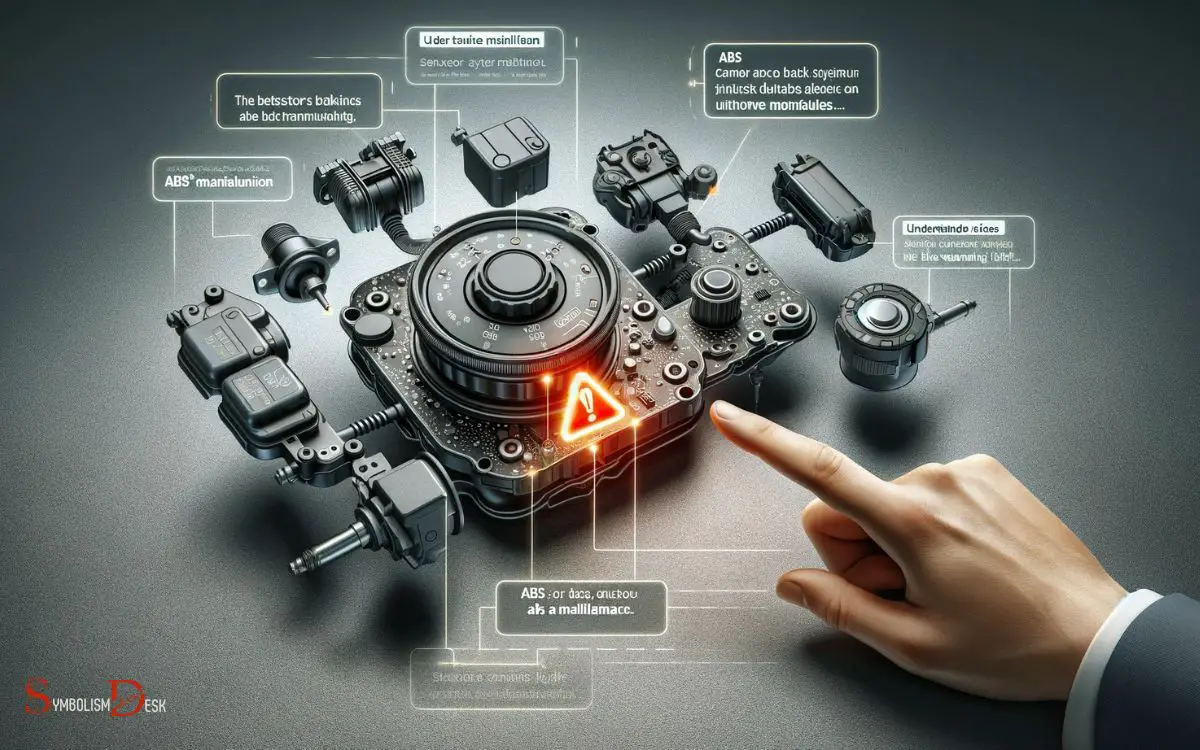
ABS Warning Light Meaning
When encountering the ABS warning light in their car, drivers should be aware of its implications and promptly address any potential malfunctions. The ABS warning light indicates a problem with the anti-lock braking system, which is a crucial safety feature in modern vehicles.
Understanding the meaning of this warning light can help drivers take appropriate action to ensure the proper functioning of their braking system.
Here are three possible reasons for the ABS warning light to illuminate:
- Wheel Speed Sensor Malfunction: This could lead to inaccurate wheel speed readings, affecting the ABS’s ability to modulate brake pressure effectively.
- Faulty ABS Module: A malfunctioning ABS module may compromise the system’s ability to regulate brake pressure during sudden stops or slippery road conditions.
- Low Brake Fluid Level: Inadequate brake fluid can impact the ABS system’s performance, triggering the warning light.
Prompt inspection and repair are essential to maintain optimal braking performance and vehicle safety.
Causes of ABS Failure
One common cause of ABS failure is a malfunctioning wheel speed sensor, which can lead to inaccurate readings and compromise the system’s ability to modulate brake pressure effectively.
Another potential cause is a damaged or corroded sensor wiring, which can disrupt the signal transmission.
Additionally, a faulty ABS module or hydraulic control unit may result in ABS failure, as these components are crucial for regulating brake pressure.
Low brake fluid levels or air bubbles in the brake fluid can also trigger ABS malfunction, affecting the system’s responsiveness.
Furthermore, worn-out brake pads or rotors can lead to irregular wheel speed and trigger the ABS warning light.
Understanding these potential causes can help car owners address ABS issues promptly, ensuring the safety and functionality of their braking system.
Handling ABS Malfunction
To effectively handle ABS malfunction, car owners can begin by understanding the common indicators and potential causes of ABS failure.
When faced with ABS issues, it’s essential to remain calm and take appropriate action to ensure safety on the road.
Here are three crucial steps to handle ABS malfunction:
- Stay Calm: Panicking can lead to poor decision-making and potentially dangerous situations. It’s important to stay composed and focused when dealing with ABS malfunctions.
- Check Brake Fluid: Low brake fluid levels can affect ABS functionality. Inspecting the brake fluid reservoir and topping it up if necessary can help address certain ABS issues.
- Seek Professional Help: If the ABS warning light remains illuminated or if there are other concerning symptoms, seeking the expertise of a qualified mechanic is crucial for diagnosing and resolving the ABS malfunction.
Seeking Professional Brake System Inspection

The first sentence for the subtopic of ‘Seeking Professional Brake System Inspection’ is: “Drivers should promptly schedule a professional brake system inspection if the brake warning light symbol appears on their car’s dashboard.”
When the brake warning light symbol illuminates, it indicates a potential issue with the braking system that requires immediate attention. When the brake warning light symbol illuminates, it indicates a potential issue with the braking system that requires immediate attention. Ignoring this warning could compromise your vehicle’s safety, as it may signal low brake fluid, worn brake pads, or a malfunction in the braking system. Understanding the car dashboard flashing symbol meaning is essential to addressing problems promptly and ensuring your vehicle operates safely on the road. Always consult your owner’s manual or a professional mechanic for further guidance.
Professional brake system inspections involve comprehensive assessments of the brake components, including the brake pads, rotors, calipers, brake lines, and brake fluid.
A certified technician can identify any underlying problems, such as worn brake pads, leaks, or malfunctioning components, and provide accurate diagnostics.
Timely professional inspection can prevent further damage, ensure optimal brake performance, and enhance overall vehicle safety.
It is essential for drivers to prioritize the safety of themselves and others on the road by seeking professional assistance at the first sign of a brake warning light.
Resetting the Brake Warning Light
When addressing the issue of resetting the brake warning light, drivers can attempt to reset the light themselves by following the vehicle’s manual or seeking guidance from a certified technician.
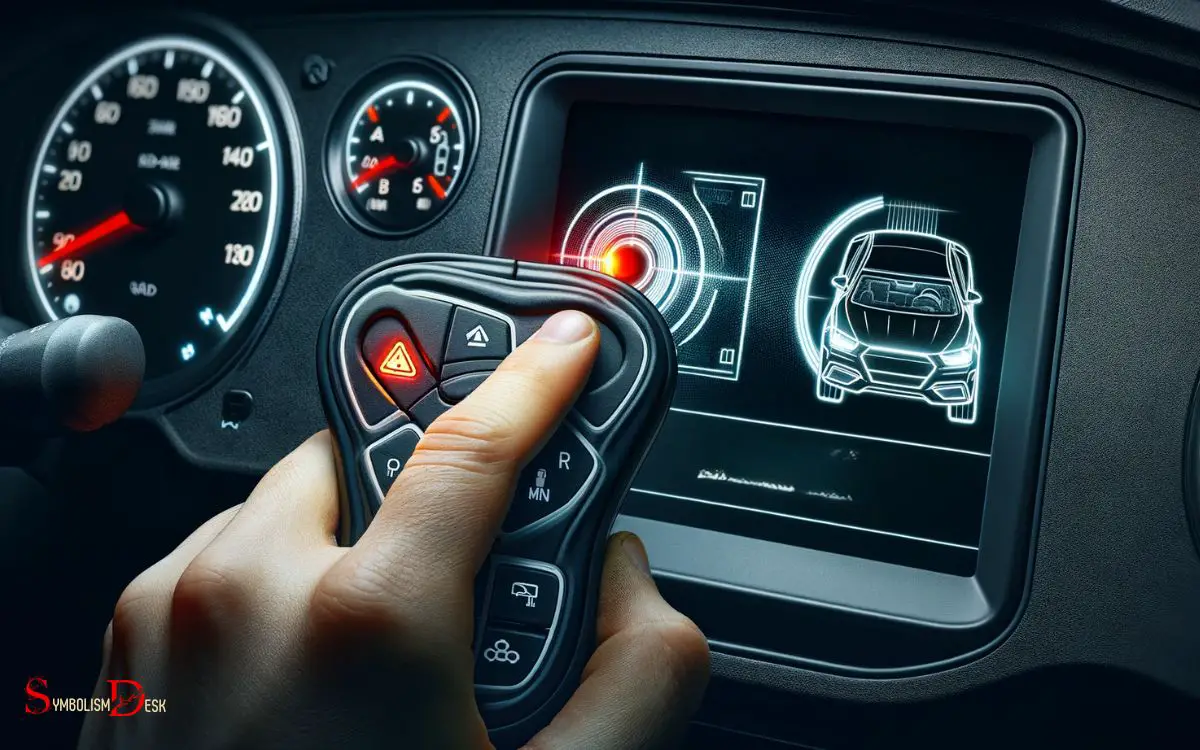
To reset the brake warning light, drivers should:
- Check the brake fluid level: Low brake fluid can trigger the brake warning light. Topping up the brake fluid to the recommended level may resolve the issue.
- Inspect the brake pads: Worn-out brake pads can also cause the brake warning light to come on. If the pads are worn, they should be replaced promptly to ensure safe braking.
- Reset the system: Some vehicles allow for manual resetting of the brake warning light through a specific sequence of actions outlined in the vehicle’s manual. Following these steps can help clear the warning light.
Brake Oil Symbol in Car
The brake oil symbol or warning light in a car typically indicates an issue with the brake system’s hydraulic fluid level or pressure. It’s essential to pay attention to this warning light, as problems with the brake system can affect your vehicle’s ability to stop safely.
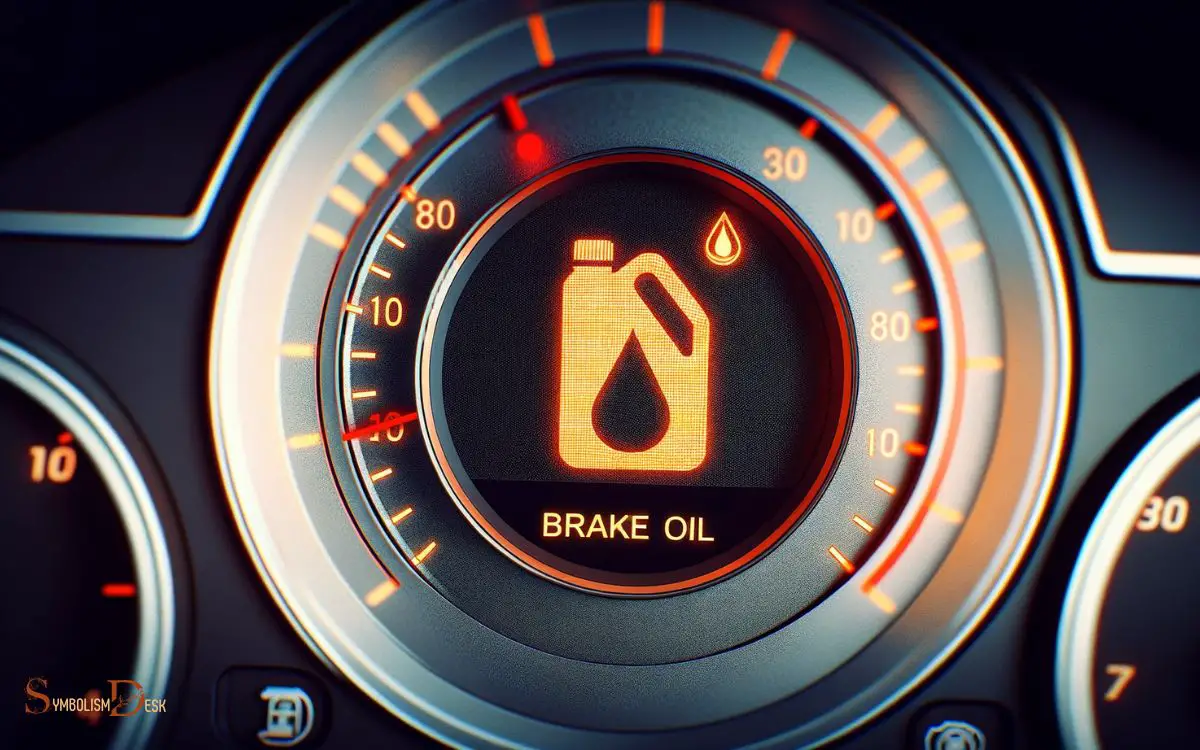
Here are some common meanings associated with the brake oil symbol:
Low Brake Fluid Level: The most common reason for the brake oil symbol to illuminate is a low brake fluid level in the brake reservoir. This can occur due to normal wear of the brake pads or a potential leak in the brake system.
Brake Fluid Contamination: Brake fluid can become contaminated over time, affecting its performance.
Contamination can be caused by moisture absorption, which reduces the fluid’s effectiveness in transmitting hydraulic pressure. When this happens, the brake oil warning light may come on.
Brake System Malfunction: In some cases, the brake oil symbol may indicate a malfunction in the brake system itself, such as a problem with the master cylinder, brake lines, or brake calipers.
Parking Brake Engagement: Some vehicles have a separate warning light for the parking brake. If you engage the parking brake while driving or forget to release it, it may trigger a warning light that resembles the brake oil symbol.
ABS (Anti-lock Braking System) Issues: In vehicles equipped with ABS, a problem with the ABS system can also trigger the brake warning light.
When you see the brake oil symbol on your car’s dashboard, it’s crucial to address the issue promptly.
Here’s what you should do:
Check Brake Fluid Level: Open the hood of your car and locate the brake fluid reservoir. Check the fluid level to see if it’s below the recommended minimum level.
If it is, you may need to add brake fluid to the reservoir. Be sure to use the type of brake fluid specified in your vehicle’s owner’s manual.
Inspect for Leaks: If the brake fluid level is consistently low, it may indicate a leak in the brake system. Inspect the brake lines, calipers, and other components for signs of brake fluid leakage. If you find a leak, it’s essential to have it repaired by a qualified mechanic.
Seek Professional Help: If you cannot determine the cause of the warning light or if you suspect a more significant issue with the brake system, it’s advisable to have your vehicle inspected by a certified mechanic or technician. They can diagnose the problem and perform the necessary repairs.
Remember that driving with a brake system warning light illuminated can be dangerous, so it’s crucial to address the issue promptly to ensure your safety on the road.
Brake Pads Symbol in Car
The brake pads symbol or warning light in a car’s dashboard typically looks like a circle with exclamation marks on both sides, representing a brake rotor and brake pad.
When this warning light comes on, it indicates an issue with the brake system that needs attention.
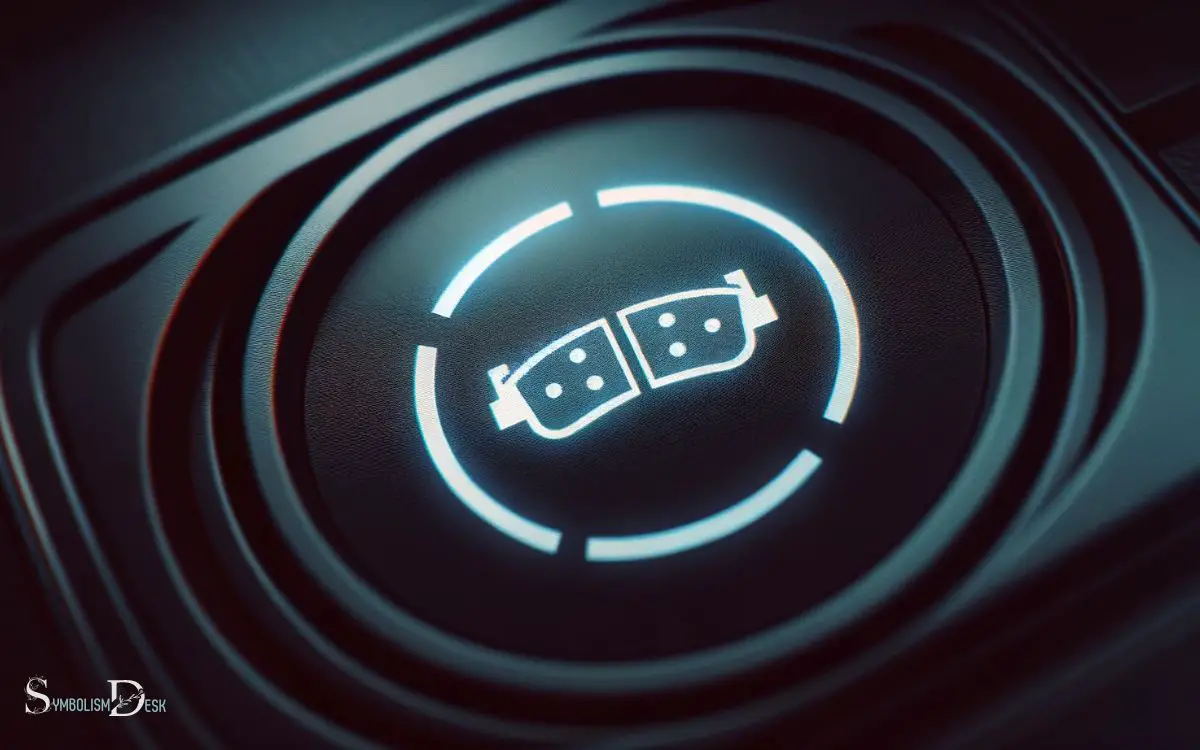
Here are some possible reasons why the brake pads warning light might illuminate:
- Worn Brake Pads: The most common reason for the brake pads warning light is that the brake pads are worn down to a level where they need to be replaced. This is a safety concern, and you should have your brake pads replaced as soon as possible.
- Brake Fluid Low: In some vehicles, a low brake fluid level can trigger the brake pads warning light. Low brake fluid can indicate a leak in the brake system or simply a need for a brake fluid top-up.
- Brake Fluid Contamination: Contaminated brake fluid can also lead to this warning light. Brake fluid can become contaminated over time, affecting braking performance.
- Brake System Malfunction: The warning light may also come on if there’s a malfunction in the brake system, such as a faulty sensor or electrical issue.
- Parking Brake Engagement: In some cars, the brake pads warning light may come on if the parking brake (handbrake) is engaged.
When you see the brake pads warning light, it’s important to take it seriously and have your vehicle inspected by a qualified mechanic as soon as possible.
Ignoring brake issues can lead to reduced braking performance and unsafe driving conditions. Always follow the manufacturer’s recommendations for maintenance and address any brake-related concerns promptly.
Conclusion
It’s crucial to heed the brake warning light to prevent potential problems. By checking fluid levels, inspecting pads and discs, and understanding ABS malfunctions, drivers can ensure their safety on the road.
Seeking professional inspection and resetting the warning light promptly can prevent costly repairs. Don’t delay – deal with the brake warning light today!



